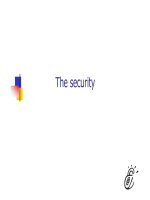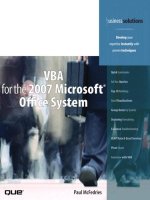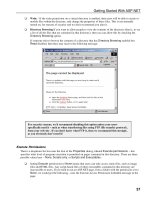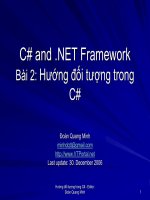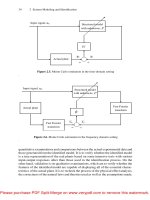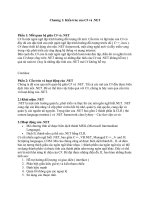Tài liệu C for The Microprocessor Engineer P2 doc
Bạn đang xem bản rút gọn của tài liệu. Xem và tải ngay bản đầy đủ của tài liệu tại đây (254.16 KB, 20 trang )
22 C FOR THE MICROPROCESSOR ENGINEER
Figure 2.2 Moving 16-bit data at òne go'.
system operations of jumping to a subroutine and implementing an interrupt,
decrement the relevant Stack Pointer before moving data. As mentioned earlier,
the Push and Pull operations allow any register or set of registers to be pushed or
pulled into or out of a stack at one go. This facilitates the passing of arguments
to and from subroutines, and allows called subroutines to use registers without
corrupting register-held data in the calling program (see Section 5.2).
Figure 2.1 shows how the post-byte is calculated for a Push or a Pull. Specif-
ically the System stack is shown; if the User stack is being employed then U is
replaced by S. Figure 2.3 shows a snapshot of memory after a Push onto the Sys-
tem stack. If only a subset of registers are saved, then the same order is preserved
as in the diagram. The time-taken for a Push or Pull is five cycles plus one cycle
per byte moved. In Fig. 2.3 this adds up to 17 cycles.
The 6809 implements the normal Add and Subtract operations, as shown in
Table 2.2, both with and without carry, targeted on an 8-bit Accumulator. An
Accumulator_D-based 16-bit Add and Subtract instruction is also provided, but
unfortunately not with a carry. An unsigned addition of Accumulator_B to the
16-bit X Index register can also be classed as double, but the 8-bit addend is
promoted to 16-bit at addition time, by assuming an upper byte of zero, hence the
terminology unsigned. Thus for example, ABX #56h actually adds the constant
0056h to X.
It is possible to promote a signed number in Accumulator_B to its 16-bit equiv-
alent in Accumulator_D by using the Sign EXtension instruction. This zeros
Accumulator_A if bit 7 of B is 0 and fills A with ones (A<-FFh) otherwise; for
example [B] = 10110011b(−83) becomes [D] = 11111111 10110011b(−83).
The Sign EXtension (SEX) instruction makes the 6809 unique as the only MPU
offering sex appeal!
Any 16-bit Index or Stack register can be summed with an 8-bit Accumulator
(which is automatically sign extended), Accumulator_D or a constant by means of
the Load Effective Address (LEA) instruction. This makes use of the arithmetic
provision which computes effective addresses in the Indexed address mode. We
will discuss this in the next section, but as an example the instruction:
LEAX 1,X ; Coded as 30-01h
ITS INSTRUCTION SET 23
Figure 2.3 Stacking registers in memory using PSH and PUL. Also applicable to IRQ and NMI interrupts.
24 C FOR THE MICROPROCESSOR ENGINEER
Table 2.2 Arithmetic operations
Flags
Operation Mnemonic V N Z C Description
Add Binary addition
to A; to B ADDA; ADDB
√ √ √ √
[A]<-[B]+[M]; [B]<-[B]+[M]
to D ADDD
√ √ √ √
[D]<-[D]+[M:M+1]
BtoX ABX • • • • [X]<-[X]+[00|B]
Add with Carry Includes carry
to A; to B ADCA; ADCB
√ √ √ √
[A]<-[A]+[M]+C; [B]<-[B]+[M]+C
Clear Destination contents zeroed
memory CLR 0 0 1 0 [M]<-00
A; B CLRA; CLRB 0 0 1 0 [A]<-00; [B]<-00
Decrement
Subtract one, produce no carry
memory DEC
1
√ √
• [M]<-[M]−1
A; B DECA; DECB
1
√ √
• [A]<-[A]−1; [B]<-[B]−1
Increment Add one, produce no carry
memory INC
2
√ √
• [M]<-[M]+1
A; B INCA; INCB
2
√ √
• [A]<-[A]+1; [B]<-[B]+1
Load Effective Address Effective Address to register
X; Y LEAX; LEAY • •
√
• [X]<-EA; [Y]<-EA
S; U LEAS; LEAU • • • • [S]<-EA; [U]<-EA
Multiply Multiplies [A] by [B]
MUL • •
√
3
[D]<-[A]× [B]
Negate Reverses 2's complement sign
memory NEG
4
√ √
5
[M]<- −[M]
A; B NEGA; NEGB
4
√ √
5
[A]<- −[A]; [B]<- −[B]
Sign Extend
Promotes signed B to signed D
SEX •
√ √
• [D]<-00|[B] or [D]<-FF|[B]
Subtract Binary subtraction
from A; from B SUBA; SUBB
√ √ √ √
[A]<-[A]−[M]; [B]<-[B]−[M]
from D SUBD
√ √ √ √
[D]<-[D]−[M:M+1]
Subt with Carry Includes carry (borrow)
from A; from B SBCA; SBCB
√ √ √ √
[A]<-[A]−[M]−C; [B]<-[B]−[M]−C
Note 1: Overflow set when passes from 10000000 to 01111111, i.e. an apparent sign change.
Note 2: Overflow set when passes from 01111111 to 10000000, i.e. an apparent sign change.
Note 3: Carry set to state of bit 7 product, i.e. MSB of lower byte; for rounding off.
Note 4: Overflow set if original data is 10000000 (−128), as there is no +128.
Note 5: Carry set if original data is 00000000; for multiple-byte negation.
ITS INSTRUCTION SET 25
calculates the effective address as [X]+1and loads it into the X Index register
([X] <- [X] + 1); thus it is the equivalent to an INcrement X (INX) instruction,
which is missing from the 6809's repertoire. Much more powerful permutations
of LEA exist, thus:
LEAY A,X ; Coded as 31-96h
promotes a signed number in Accumulator_A to 16-bits, adds this to the con-
tents of the X Index register and puts the result in the Y Index register ([Y] <-
SEX|[A] + [X])!
The contents of any read–write memory location, or any 8-bit Accumulator can
be directly incremented or decremented by using the INC or DEC instruction. As
noted, the X,Y,S,U registers can be similarly augmented by using the LEA instruc-
tion. Notice that INC and DEC do not set the Carry flag, which makes multiple-byte
Increment and Decrement operations awkward (use ADD #1 and SUB #1 instead).
Increment sets the oVerflow flag when the target goes from 0,1111111b through
to 1,0000000b (seemingly from + to −) and Decrement likewise when going from
1,0000000b through to 0,1111111b (− to +). INC and DEC on memory are classi-
fied as read–modify–write operations, as during execution, data is fetched from
memory, modified and then sent back. Clearing (CLR) memory strangely works
in the same way — although the original value is irrelevant.
It is possible to multiply the two 8-bit Accumulator contents using the MUL in-
struction, giving a 16-bit product overwriting the original contents of Accumula-
tor_D; thus
A
A
× B
B
leads to
A × B
D
. For this purpose
the multiplier and multiplicand are treated as unsigned. The 16-bit product may
be truncated by using only the contents of Accumulator_A as the outcome, effec-
tively dividing by 256 (equivalent to moving the binary point left eight places).
Instead of truncating, this 8-bit product may be rounded off by adding the MSB
of Accumulator_B to Accumulator_A, in effect adding the
1
2
bit. To facilitate this,
MUL sets the C flag to the state of bit 7 of B. Thus the sequence:
MUL ; Multiply [A] and [B] giving a 16-bit product as [D]
ADCA #0 ; Add Carry to [A] (now can disregard contents of B)
would give the required rounded 8-bit product in Accumulator_A.
It is of course possible to multiply or divide by powers of two by shifting left
or right as appropriate. Also a combination of shift and add or shift and subtract
can be used to multiply or divide by any number [3]. Table 2.3 gives the range of
Shift instructions available. All of these operate on an 8-bit Accumulator or on
any read/write memory location through the read–modify–write mechanism.
Linear Arithmetic Shift instructions move the 8-bit operand left or right with
the Carry flag catching the emerging bit. In the case of ASR, the sign bit propagates
right; thus 1,1110100b (−12) becomes 1,1111010b (−6) → 1,1111101b (−3) etc.
and 0,0001100b (+12) becomes 0,0000110 (+6) → 0,0000011b (+3) etc. The
Logic Shift Right equivalent always shifts in zeros from the left. Logic Shift
Left and Arithmetic Shift Left are equivalent, and some assemblers permit
the use of the alternative LSL mnemonic.
26 C FOR THE MICROPROCESSOR ENGINEER
Table 2.3 Shifting Instructions.
Flags
Operation Mnemonic V N Z C Description
Shift left, arithmetic or logic Linear shift left into carry
memory ASL
1
√ √
b
7
A; B ASLA; ASLB
1
√ √
b
7
C ← ← 0
Shift right, logic Linear shift right into carry
memory LSR •
√ √
b
0
A; B LSRA; LSRB •
√ √
b
0
0 → → C
Shift right, arithmetic As above but keeps sign bit
memory ASR •
√ √
b
0
A; B ASRA; ASRB
•
√ √
b
0
b
7
→ → C
Rotate left Circular shift left into carry
memory ROL
1
√ √
b
7
A; B ROLA; ROLB
1
√ √
b
7
C ←
← C
Rotate right Circular shift right into carry
memory ROR •
√ √
b
0
A; B RORA; RORB •
√ √
b
0
C → → C
Note 1: V=b
7
⊕b
6
before shift.
Circular or Rotate Shift instructions are similar to Add with Carry, in that they
can be used for multiple-precision operations. A Rotate takes in the Carry from
any previous Shift and in turn saves its ejected bit in the C flag. As an example,
a 24-bit word stored in
24
M
16 15
M+1
8 7
M+2
0
can be shifted
right once by the sequence [4]:
LSR M ; 0 →
⇒
M
b
16
→ C
ROR M+1 ; b
16
/ C → ⇒
M+1
b
8
→ C
ROR M+2 ; b
8
/ C → ⇒
M+2
b
0
→ C
In all types of Left Shifts, the oVerflow flag is set when bits 7 and 6 differ
before the shift (i.e. b
7
⊕
b
6
), meaning that the (apparent) sign will change after
the shift.
The logic operations of AND, OR, Exclusive-OR and NOT (Complement) are
provided, as shown in Table 2.4. The only unusual feature here is the special
instructions of ANDCC and ORCC for clearing or setting flags in the Code Condition
register. Thus to clear the I mask (see Fig. 1.1) we have:
ITS INSTRUCTION SET 27
ANDCC #11101111b ; Coded as 1C-EFh (equivalent to CLI)
and to set it:
ORCC #00010000b ; Coded as 1A-10h (eqivalent to SEI)
This saves having to provide a series of separate instructions targeted at each
of the CCR flags and masks, such as the 6800's CLI and SEI (CLear and SEt
Interrupt mask), and also allows more than one flag to be set or cleared in a
single instruction.
Table 2.4 Logic instructions.
Flags
Operation Mnemonic V N Z C Description
AND Logic bitwise AND
A; B ASL 0
√ √
• [A]<-[A]·[M]; [B]<-[B]·[M]
CC ANDCC #nn Can clear [CCR]<-[CCR]·#nn
Complement Invert (1's complement)
memory COM 0
√ √
1 [M]<-[M]
A; B COMA; COMB 0
√ √
1 [A]<-[A]; [B]<-[B]
Exclusive-OR Logic bitwise Exclusive-OR
A; B EORA; EORB 0
√ √
• [A]<-[A]⊕[M]; [B]<-[B]⊕[M]
OR
Logic bitwise Inclusive-OR
A; B ORA; ORB 0
√ √
• [A]<-[A]+[M]; [B]<-[B]+[M]
CC ORCC #nn Can set [CCR]<-[CCR]+#nn
The setting of the CCR flags can be used after an operation to make some
deduction about, and hence act on, the state of the operand data. Thus, to deter-
mine if the value of a port located at, say, 8080h is zero, then:
LDA 8080h ; Move in data & setZ&Nflagsasappropriate {86-80-80h}
BEQ SOMEWHERE ; Go somewhere if Z flag EQuals zero {27-xxh}
will bring its contents into Accumulator_A and set the Z flag if it is zero. Branch
if EQual to zero will then cause the program to skip to another place. The
N flag is also set if bit 7 is logic 1, and thus a Load operation can enable us to
test the state of this bit. The problem is, loading destroys the old contents of the
Accumulator, and the new data is probably of little interest. A non-destructive
equivalent of loading is TeST, as shown in Table 2.5. The sequence now becomes:
TST 8080h ; Check data & setZ&Nflagsasappropriate {7D-80-80h}
BEQ SOMEWHERE ; Go somewhere if Z flag EQuals zero {27-xxh}
but the Accumulator contents are not overwritten. However, 16-bit tests must
be carried out using a 16-bit Load operation as only 8-bit TeST instructions are
provided.
TeST can only check for all bits zero or the state of bit 7. For data already in
an 8-bit Accumulator, ANDing can check the state of any bit; thus:
28 C FOR THE MICROPROCESSOR ENGINEER
Table 2.5 Data test operations.
Flags
Operation Mnemonic V N Z C Description
Bit Test Non-destructive AND
A; B BITA; BITB 0
√ √
• [A]·[M]; [B]·[M]
Compare Non-destructive subtract
with A; B CMPA; CMPB
√ √ √ √
[A]−[M]; [B]−[M]
with D CMPD
√ √ √ √
[D]−[M:M+1]
with X; Y CMPX; CMPY
√ √ √ √
[X]−[M:M+1]; [Y]−[M:M+1]
with S; U CMPS; CMPU
√ √ √ √
[S]−[M:M+1]; [U]−[M:M+1]
Test for Zero or Minus Non-destructive subtract from zero
memory TST 0
√ √
• [M]−00
A; B TSTA; TSTB 0
√ √
• [A]−00; [B]−00
ANDB #00100000b ; Clear all Accumulator B bits except 5 {C4-20h}
will set the Z flag if bit 5 is 0, otherwise Z will be cleared. Once again this is a
destructive examination, and the equivalent from Table 2.5 is BIT test; thus:
BITB #00100000b ; Coded as C5-20h
does the same thing, but with the contents of Accumulator_B remaining un-
changed; and more tests can subsequently be carried out without reloading.
Comparison of the magnitude of data in an Accumulator with either a constant
or data in memory requires a different approach. Mathematically this can be
done by subtracting [M] from [A] and checking the state of the flags. Which
flags are relevant depend on whether the numbers are to be treated as unsigned
(magnitude only) or signed. Taking the former first gives:
[A] Higher than [M]:[A]−[M] gives no Carry and non-Zero C=0, Z=0 (
C + Z=1)
[A] Equal to [M]:[A]−[M] gives Zero (Z=1)
[A] Lower than [M]:[A]−[M] gives a Carry (C=1)
The signed situation is more complex, involving both the Negative and oVer-
flow flag. Where a subtraction occurs and the difference is positive, then either
bit 7 will be 0 and there will be no overflow (both N and V are 0) or else an overflow
will occur with bit 7 at logic 1 (both N and V are 1). Logically, this is detected by
the function
N
⊕
V.Anegative difference is signalled whenever there is no over-
flow and the sign bit is 1 (N is 1 and V is 0) or else an overflow occurs together
with a positive sign bit (N is 0 and V is 1). Logically, this is N
⊕
V. Based on these
outcomes we have:
[A] Greater than [M]:[A]−[M] → non-zero +ve result (N
⊕
V
·
Z = 1 or N
⊕
V
+
Z = 0)
[A] Equal to [M]:[A]−[M] → zero (Z=1)
[A] Less than [M]:[A]−[M] → a negative result (N
⊕
V = 1)
Subtraction is a destructive test operation and Comparison is its non-destructive
counterpart. It is the most powerful of the Data Testing operations, as it can be
ITS INSTRUCTION SET 29
applied to both Index and Stack Pointer registers as well as 8- and 16-bit Accu-
mulators.
Table 2.6 Operations which affect the Program Counter.
Operation Mnemonic Description
Bcc cc is the logical condition tested
LBcc
Always (True) BRA; LBRA Always affirmed regardless of flags
Never (False) BRN; LBRN Never carried out
Equal BEQ; LBEQ Z flag set (Zero result)
not Equal BNE; LBNE Z flag clear (Non-zero result)
Carry Set BCS; LBCS
1
[Acc] Lower Than (Carry = 1)
Carry Clear BCC; LBCC
2
[Acc] Higher or Same as (Carry = 0)
Lower or Same BLS; LBLS [Acc] Lower or Same as (C+Z=1)
Higher Than BHI; LBHI [Acc] Higher Than (C+Z=0)
Minus BMI; LBMI N flag set (Bit 7 = 1)
Plus BPL; LBPL N flag clear (Bit 7 = 0)
Overflow Set BVS; LBVS V flag set
Overflow Clear BVC; LBVC V flag clear
Greater Than
BGT; LBGT [Acc] Greater Than (N ⊕ V · Z = 1)
Less Than or Equal
BLE; LBLE [Acc] Less Than or Equal (N ⊕ V · Z = 0)
Greater Than or Equal
BGE; LBGE [Acc] Greater Than or Equal (N ⊕ V = 1)
Less Than
BLT; LBLT [Acc] Less Than (N ⊕ V = 0)
Jump JMP Absolute unconditional goto
No Operation NOP Only increments Program Counter
2's complement Branch
Note 1: Some assemblers allow the alternative BLO.
Note 2: Some assemblers allow the alternative BHS.
All Conditional operations in the 6809 are in the form of a Branch instruction.
These cause the Program Counter to skip xx places forward or backwards; usu-
ally based on the state of the CCR flags. Excluding Branch to SubRoutine (see
Section 5.1), there are 16 Branches provided, which can be considered as the True
or False outcome of eight flag combinations. Thus Branch if Carry Set (BCS)
and Branch if Carry Clear (BCC) are based on the one test (C =?).
If the test is True, the offset following the Branch op-code is added to the
Program Counter. Thus if the Carry flag is zero:
E100:1 BCC-08 ; Coded as 24-08h
